S-comma

S-comma (majuscule: Ș, minuscule: ș) is a letter which is part of the Romanian alphabet, used to represent the sound /ʃ/, the voiceless postalveolar fricative (like sh in shoe).
History
[change | change source]

The letter was proposed in the Buda Lexicon, a book published in 1825, which included two texts by Petru Maior, Orthographia romana sive latino-valachica una cum clavi and Dialogu pentru inceputul linbei române, introducing ș for /ʃ/ and ț for /ts/.[1]
Unicode support
[change | change source]S-comma was not initially supported in early Unicode versions, nor in the predecessors like ISO/IEC 8859-2 and Windows-1250. Instead, Ş (S-cedilla), a character available since Unicode 1.1.0 (1993), was used for digital texts written in Romanian. In some contexts, like with low-resolution screens and printouts, the visual distinction between ș and ş is minimal. In 1999, at the request of the Romanian Standardization Association[source?], S-comma was introduced in Unicode 3.0. Nevertheless, encoding for the S-comma was not supported in retail versions of Microsoft Windows XP, but a later European Union Expansion Font Update provided the feature. While digital accessibility to S-comma has since improved, both characters continue to be used interchangeably in various contexts like publishing.
The letter is part of Unicode's Latin Extended-B range, under "Additions for Romanian", titled as "Latin capital letter S with comma below" (U+0218) and "Latin small letter s with comma below" (U+0219).[2] In HTML, these can be encoded by Ș and ș, respectively.
Use of the comma with the letter S
[change | change source]Șș
| |||||||||||||||||||||||||||||||||||||||||||||||||||||||||||
|---|---|---|---|---|---|---|---|---|---|---|---|---|---|---|---|---|---|---|---|---|---|---|---|---|---|---|---|---|---|---|---|---|---|---|---|---|---|---|---|---|---|---|---|---|---|---|---|---|---|---|---|---|---|---|---|---|---|---|---|
| S-comma | |||||||||||||||||||||||||||||||||||||||||||||||||||||||||||
| |||||||||||||||||||||||||||||||||||||||||||||||||||||||||||
- Romanian
- The Romanian letter Ș/ș (S with comma) represents the voiceless postalveolar fricative /ʃ/ (as in "show"). On outdated systems which do not support the glyph, the symbol Ş/ş (S with cedilla) is used. Example word: Timișoara.
Character encoding
[change | change source]References
[change | change source]- ↑ Marinella Lörinczi Angioni, "Coscienza nazionale romanza e ortografia: il romeno tra alfabeto cirillico e alfabeto latino ", La Ricerca Folklorica, No. 5, La scrittura: funzioni e ideologie. (Apr., 1982), pp. 75–85.
- ↑ Unicode code charts. Latin Extended-B: Range 0180–024F
